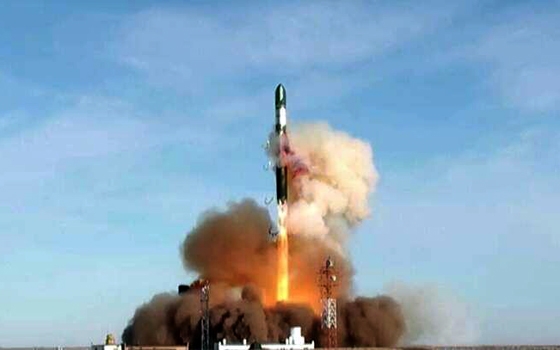The Emirates Institution for Advanced Science and Technology (EIAST) has announced the successful launch of Dubai Sat-2 into outer space today (November 21, 2013) promptly at 11:10am UAE local time. The successful launch marks another accomplishment for the UAE in aerospace and complements EIAST’s achievements in the fields of space science and advanced technology, which further consolidates the country’s pioneering status in the global space industry map. Dubai Sat-2 was launched into outer space from the Yasny Launch Base in Russia, using the Russian Dnepr rocket launcher in cooperation with the Russian International Space Company (Kozmotras), under the supervision of EIAST representatives and team of engineers.
According to EIAST, the UAE team of engineers at the ground station was able to communicate directly with Dubai Sat-2, which entered orbit 15 minutes and 33 seconds after its launch and accurately determined the path of the satellite. Thereafter, the process of establishing the first link with the satellite through the telecommunication system has commenced and the first telemetries and satellite status was received. The speed of Dubai Sat-2 is 7.55 km/S until it passes 600 km above earth.
Dubai Sat-2 is equipped with an electrical propulsion system that allows the control of its altitude above ground level and modifies it automatically in the event of any deviation from the orbit through a set of predetermined and saved commands sent from the control station. The new satellite is equipped with innovative technology to enhance the maneuvering capability and increase its agility by 300 per cent, as compared to Dubai Sat-1.
The satellite has automatically deployed the solar panels that represent the main source of electric power needed to run the satellite systems during its presence in outer space, which extends to five years from the date of launch. The satellite makes one full orbit around the earth in 96 minutes with 60 percent of its time facing the sun light.
H.E. Yousuf Al Shaibani, Director General, Emirates Institution for Advanced Science and Technology, said: “We take great pride in this new accomplishment, which highlights Dubai’s great development in terms of building national UAE capacities in the space field—a feat that remains true to the vision of HH Sheikh Mohammed bin Rashid Al Maktoum, UAE Vice President and Prime Minister and Ruler of Dubai, of transforming UAE into a pioneering nation. The success of launching Dubai Sat-2 into the outer space is the cultivation of years of vision and hard work to achieve future aspirations to make the UAE a global hub for building satellites and a leading center for space technology.”
He added: “We would like to express our sincerest gratitude and appreciation to the team of Emirati and South Korean engineers who made strenuous efforts to develop the satellite on time in accordance with the highest international standards adopted by the space industry in cooperation with Satrec Initiative. After the success of Dubai Sat-1 and Dubai Sat-2, we now look forward to the launch of Dubai Sat-3 to outer space in 2017 as part of our relentless quest to lead the scientific renaissance in the UAE. Dubai Sat-3 is of great importance because it’s the first satellite to be built and completed by a team of UAE engineers on UAE soil. We look forward to increase our investments in the UAE human capital and establish the culture of advanced scientific research and technological innovation, which serves the objectives of the Dubai Strategic Plan and UAE Vision 2021 in order to build a sustainable knowledge based economy.”
Amer Al Sayegh, Director of the Space Systems Development Department at EIAST and Dubai-Sat-3 Project Manager, said: “Dubai Sat-2 weighs 300 kg and is 2 meters high and 1.5 meters wide. DubaiSat-2 has been designed to provide higher quality, electro-optical imagery with a panchromatic resolution of 1m for various applications including environmental projects, urban planning and infrastructure. The satellite is equipped to provide space imagery of the entire world throughout its lifetime and can take multiple images of the same area in one day, as well as receive and process these images from anywhere in the world within one day.
“Dubai Sat-2 consists of two main segments, the DubaiSat-2 Space Segment, which consists of a spacecraft bus and an electro-optical payload that contains a push-broom camera with TDI sensors to provide space images, while the DubaiSat-2 Ground Segment includes the Main Mission Control Station (MCS), Subsidiary MCS, Main Image Receiving and Processing Station (IRPS), Customer IRPS, and Antenna system. The final data from Dubai Sat-2 will be used to several civilian applications, as well as provide 3D images, follow the developments of projects and provide specialized reports,” added Al Sayegh.
EIAST was established by the Dubai Government in 2006 with the goal of promoting a culture of advanced scientific research and technology innovation in Dubai and the UAE, and enhancing technology innovation and scientific skills among UAE Nationals. It is mainly involved in outer space research and development; satellite manufacturing and systems development; space imaging; and ground station services and support for other satellites.
ifpinfo
21 November






















































